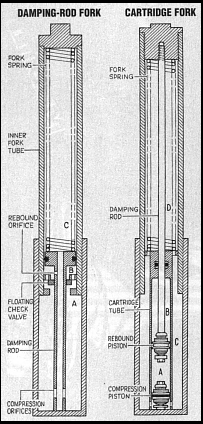
Let's say you're bopping down the road, you charge into a corner and hit the brakes, the font dives radically and the bike feels like a wallowing pig. The later on you hit a square-edge bump and it feels like your wrists are going to break. Wait a minute, First the bike was too soft, then too harsh, What gives?
Well, perhaps the problem is your basic fork design. Internally, there are two types of forks, damping-rod and cartridge. If you have an old-style damping-rod fork, you're fighting and uphill battle (there are excellent solutions for that design but we won't get into that now).
A damping-rod fork is fairly simple: all that happens is oil is shoved through fixed orifices. This type of damping is call "velocity-squared" damping. The faster the wheel moves vertically, the more oil is shoved through the holes.
This is an important point. The speed of the bike is not nearly as critical as the shape of the bump. If you have 2-inch high bumps that's square-edged, the wheel has to move vertically very quickly, even at low speeds. On the other hand, if the 2-inch bump has a ramp that's 2 feet long, you can imagine that the vertical wheel velocity is much less. Now, of course, the bike speed does matter: if you double the bike speed over particular bump, you will double the vertical wheel velocity.
If the vertical velocity is doubled, the oil-flow rate through the damping holes is doubled. The interesting thing about fluid flow through fixed orifices is that the damping resistance is not doubled but instead increase with the square of the velocity; in other words, it increase by four times.
This situation is sometimes referred to as hydraulic lock. At some point the damping force increases so rapidly that the eintire bike defelects instad of the suspension absorbing the bump.

The problem is that "fixed orifice" damping-rod forks are too progressive. Fixed-orifice forks have very little "low-speed" damping and a lot of "high-speed" damping (vertical wheel speed). With very little low-speed camping, the fork dives excessively, and with a lot of high-speed damping you'll get a harsh spike: the worst of both worlds.
Another limitation is revealed during revalving. Typically, revalving a damper-rod fork involves enlarging or reducing the holes, or installing thinner- or thicker-viscosity suspension fluids (there are other solutions). This decreases or increase the damping through the entire speed ranges, to the bike is better handling the spike but will be better at handling the spike but will be even worse under hard braking, or vice versa. These changes will get you in the ballpark but almost always have compromises.
One solution is a cartridge fork. Mechanically, most cartridge forks use bending-shim-type construction instead of fixed orifices. This means there's a damping piston with a series of shims (they look like thin washers). The shims are stacked up against the face of the piston. When the oil flows through the piston, it forces the shims to deflect away from the piston face.
This creates damping at very low velocities. At very high wheel velocities, the shims deflect more and don't create as much high speed damping as fixed-orifice-type designs, meaning that the spike on square-edge bumps is reduced. With a cartridge fork, the damping is less progressive than with damping rods.

An added advantage of a cartridge fork is that the damping curve can be modified, or revalved, in a much more precise manner. For example, if you need less high-speed compression damping but the low-speed is perfect, the high-speed can be modified without affecting the low-speed compression because each circuit is affected by different shims when properly set up.
So, if your bike already has a cartridge fork, great. Inherently, the cartridge fork is headed in the right direction; it has more tunability and can be dialed in to your riding requirements and ability.
Does this mean any cartridge fork is better than any damping-rod fork? No, that depends on the valving and setup, including spring rate and oil level. Being a savvy suspension turner requires a knowledge of advanced engineering theory, the experience of extensive testing and art. something to remember is, the best you've ridden is the best you know.
Is there any hope for the damping-rod fork? Yes, but it takes more than a little creativity and...well, that's another story.
Paul Thede is the creative force behind Race Tech in Pomona, California, which has been modifying and creating suspension products for the last 10 years